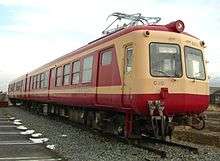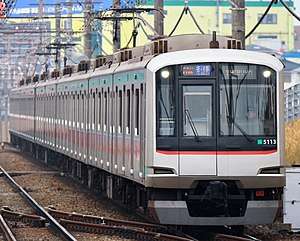Tokyu 5000 series (1954)
The Tokyu 5000 series (東急5000系, Tōkyū 5000-kei) was an electric multiple unit (EMU) train type operated by the private railway operator Tokyu Corporation in Japan from 1954 until 1986.
| Tokyu 5000 series | |
|---|---|
A 5000 series and a 5200 series train on the Tokyu Toyoko Line in March 1980 | |
| In service | 1954–1986 |
| Manufacturer | Tokyu Car |
| Constructed | 1954–1959 |
| Entered service | October 16, 1954 |
| Number built | 105 cars |
| Formation | 3–6 cars per trainset |
| Operator(s) | Tokyu Corporation Various local private railways |
| Specifications | |
| Car length | 18,000 mm (59 ft 1 in) |
| Doors | 3 per side |
| Electric system(s) | 1,500 V DC overhead lines |
| Current collection method | Pantograph |
| Bogies | TS-301[1] |
| Track gauge | 1,067 mm (3 ft 6 in) |
Specifications
Formations
The trains were formed as three-car sets, and were later lengthened to up to six cars per trainset.
History
The trains entered service on October 16, 1954.[4] A total of 105 cars were built by Tokyu Car from 1954 to 1959. Toyoko Line services operated with 5000 series trains ended in March 1980.
The 5000 series was withdrawn from Meguro Line services in June 1986, and the trains were retired after a farewell run in July 1986.
New Tokyu 5000 series set 5122 received a green vinyl wrapping livery in September 2017, reminiscent of the original 5000 series' livery.[5]
Other operators
About 70 former Tokyu 5000 series vehicles were transferred to other operators. Transfer of former 5000 series trains to Nagano Electric Railway began in 1977. They were also operated by Gakunan Railway, Ueda Electric Railway, Matsumoto Electric Railway, Fukushima Kotsu, and Kumamoto Electric Railway.[4]
 Gakunan 5000 series in September 2004
Gakunan 5000 series in September 2004 Ueda Kotsu 5000 series in September 1986
Ueda Kotsu 5000 series in September 1986 Nagaden 2500 series in May 1988
Nagaden 2500 series in May 1988 Matsuden 5000 series
Matsuden 5000 series Kumamoto 5000 series in September 2006
Kumamoto 5000 series in September 2006
Preserved examples
- Deha 5001: preserved in front of Shibuya Station, Tokyo, scheduled to be relocated to Odate, Akita in June 2020
- Matsumoto Electric Railway (Matsuden): one train stored, was repainted into its former Tokyu livery in 2012
- 5001 in January 2008
- Matsuden train in June 2012
 Nagaden 2500 series set C10 at the "Train Gallery Nagano" in Suzaka, Nagano Prefecture, January 2011
Nagaden 2500 series set C10 at the "Train Gallery Nagano" in Suzaka, Nagano Prefecture, January 2011
References
- "TS-301/岳南鉄道5000系" [TS-301 / Gakunan Railway 5000 series]. rail.hobidas.com (in Japanese). Neko Publishing. October 12, 2005. Archived from the original on January 30, 2020. Retrieved February 22, 2020.
- Miyata, Michikazu; Hirooka, Yuki (2014). 東急電鉄まるごと探見 [Explore the entire Tokyu Corporation] (in Japanese). JTB Publishing. pp. 49–52. ISBN 9784533096945.
- "東急東横線90周年祝い、5050系に「青ガエル」ラッピング 9/4登場" [Tokyu Toyoko Line 90th Anniversary celebration, "green frog" wrapping on 5050 series, 9/4 appearance]. tetsudo-ch.com (in Japanese). EXPRESS Co., Ltd. August 26, 2017. Archived from the original on July 27, 2019. Retrieved February 22, 2020.
- "東急5000系「青ガエルラッピング電車」の運転開始" [Tokyu 5000 series enters service in "green frog" wrapping livery]. Japan Railfan Magazine Online (in Japanese). Japan: Koyusha Co., Ltd. September 5, 2017. Archived from the original on September 6, 2017. Retrieved February 22, 2020.
| Wikimedia Commons has media related to Tōkyū 5000 series. |


